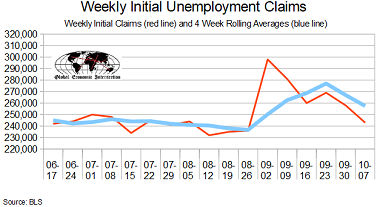
Hurricanes Harvey, Irma and Maria impacted this week’s claims – but significantly less than previous weeks. The market expectations for weekly initial unemployment claims (from Bloomberg / Econoday) were 250 K to 275 K (consensus 252,000), and the Department of Labor reported 243,000 new claims. The more important (because of the volatility in the weekly reported claims and seasonality errors in adjusting the data) 4 week moving average moved from 267,000 (reported last week as 268,250) to 257,500. The rolling averages generally have been equal to or under 300,000 since August 2014.
Analyst Opinion of Initial Unemployment Claims
This marks 133 consecutive weeks of initial claims below 300,000, the longest streak since 1970. The general trend of the 4 week rolling average is a slowing rate of improvement year-over-year which historically suggests a slowing economy.
It should be pointed out that Econintersect watches the year-over-year change on the 4 week moving average. There is always some seasonality which migrates into the seasonally adjusted data, and year-over-year comparisons helps remove some seasonality. The four week rolling average of initial claims are 3.0 % higher (better than the 6.2 % higher for last week) than they were in this same week in 2016.
Claim levels are at 40 year lows (with the normal range around 350,000 weekly initial unemployment claims of levels seen historically during times of economic expansion – see chart below).

From the Department of Labor:
In the week ending October 7, the advance figure for seasonally adjusted initial claims was 243,000, a decrease of 15,000 from the previous week’s revised level. The previous week’s level was revised down by 2,000 from 260,000 to 258,000. The 4-week moving average was 257,500, a decrease of 9,500 from the previous week’s revised average. The previous week’s average was revised down by 1,250 from 268,250 to 267,000. Hurricanes Harvey, Irma, and Maria impacted this week’s claims.
The advance seasonally adjusted insured unemployment rate was 1.3 percent for the week ending September 30, a decrease of 0.1 percentage point from the previous week’s unrevised rate. The advance number for seasonally adjusted insured unemployment during the week ending September 30 was 1,889,000, a decrease of 32,000 from the previous week’s revised level. This is the lowest level for insured unemployment since December 29, 1973 when it was 1,805,000. The previous week’s level was revised down by 17,000 from 1,938,000 to 1,921,000. The 4-week moving average was 1,925,000, a decrease of 11,500 from the previous week’s revised average. The previous week’s average was revised down by 10,500 from 1,947,000 to 1,936,500.














Leave A Comment